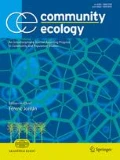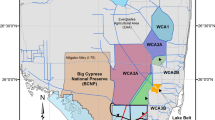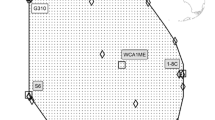Abstract
In this paper, we want to support the idea of using a family of indices of similarity, that we call the Simpson’s family indices or nestedness-based similarity functions (NBSF) for comparing operational geographic units (OGUs) (phytosociological relevés, animal traps, watersheds, administrative units, industrial areas, islands etc.). In these cases, similarity-dissimilarity depends, in addition to factors that induce replacement, also on factors that produce reduction or increment in the number of features within the same typology of OGUs (e.g., extent, reduction of fertility, anthropogenic pressure etc.). To keep into consideration this aspect, the indices are defined to be equal to 1 when the OGUs are completely nested. The results of the application to four simulated data sets prove that, when the data set does not show clear nested pattern, the use of NBSF produces results similar to the nestedness-free similarity functions, however since NBSF clearly detect nested situations, we should prefer their use in the circumstances where we think important to put in evidence nestedness. In conclusion, we support the idea of using both types of indices in order to improve the knowledge about the structure of any data set.
Similar content being viewed by others
Abbreviations
- NBSF:
-
Nestedness-Based Similarity Functions
- NFSF:
-
Nestedness-Free Similarity Functions
- OGU:
-
Operational Geographic Unit
References
Atmar, W. and B.D. Patterson. 1993. The measure of order and disorder in the distribution of species in fragmented habitat. Oecologia 96:373–382.
Atmar, W. and B.D. Patterson. 1995. The nestedness temperature calculator: a visual basic program, including 294 presence-absence matrices. AICS Research Inc, University Park, New Mexico, USA and the Field Museum, Chicago, IL, USA.
Baselga, A. 2010. Partitioning the turnover and nestedness components of beta diversity. Glob. Ecol. Biogeogr. 19:134–143.
Baselga, A. and F. Leprieur. 2015. Comparing methods to separate components of beta diversity. Meth. Ecol. Evol. 6(9):1069–1079.
Bustos, S., C. Gomez, R. Hausmann and C.A. Hidalgo. 2012. The dynamics of nestedness predicts the evolution of industrial ecosystems. PLoS One 7(11): e49393.
Carvalho, J.C., P. Cardoso, P.A.V. Borges, D. Schmera and J. Podani. 2013. Measuring fractions of beta diversity and their relationships to nestedness: a theoretical and empirical comparison of novel approaches. Oikos 122(6):825–834.
Crovello, T.J. 1981. Quantitative biogeography: an overview. Taxon 30:563–575.
Feoli, E. and V. Zuccarello. 1996. Spatial pattern of ecological processes: the role of similarity in GIS applications for landscape analysis. In: M. Fisher, H. Scholten and D. Unwin (eds), Spatial Analytical Perspectives on GIS. Taylor and Francis, London. pp. 175–185.
Feoli, E., R. Pérez-Gómez, C. Oyonarte and J.J. Ibáñez. 2017. Using spatial data mining to analyze area-diversity patterns among soil, vegetation, and climate: A case study from Almería, Spain. Geoderma 287:164–169.
Ibáñez, J.J., R. Pérez-Gómez, P. Ganis and E. Feoli. 2016. The use of vegetation series to assess α and β vegetation diversity and their relationships with geodiversity in the province of Almeria (Spain) with watersheds as operational geographic units. Plant Biosystems 150(6):1395–1407.
Legendre, P. 2014. Interpreting the replacement and richness difference components of beta diversity. Glob. Ecol. Biogeogr. 23:1324–1334.
Podani, J. 2000. Introduction to the Exploration of Multivariate Biological Data. Backhuys, Leiden, NL.
Podani, J. and D. Schmera. 2011. A new conceptual and methodological framework for exploring and explaining pattern in presence-absence data. Oikos 120:1625–1638.
Podani, J. and D. Schmera. 2012. A comparative evaluation of pairwise nestedness measures. Ecography 35:889–900.
Podani, J. and D. Schmera. 2016. Once again on the components of pairwise beta diversity. Ecol. Informatics 32:63–68.
Orlóci, L. 1978. Multivariate Analysis in Vegetation Research. 2nd edition. Junk, The Hague.
Simpson, G.G. 1943. Mammals and the nature of continents. Amer. J. Sci. 241:1–31.
Simpson, G.G. 1960. Notes on the measurement of faunal resemblance. Amer. J. Sci. 258(2):300–311.
Ulrich, W and M. Almeida-Neto. 2012. On the meanings of nestedness: back to the basics. Ecography 35:1–7.
Ulrich, W., M. Almeida-Neto and N. Gotelli. 2009. A consumer’s guide to nestedness analysis. Oikos 118:3–17.
Zadeh, L.A. 1965. Fuzzy sets. Inform. Control 8:338–353.
Author information
Authors and Affiliations
Corresponding author
Rights and permissions
About this article
Cite this article
Feoli, E., Ganis, P., Ibáñez, J.J. et al. On the use of nestedness-based similarity functions (NBSF) to classify and/or order operational geographic units (OGUs). COMMUNITY ECOLOGY 20, 223–229 (2019). https://doi.org/10.1556/168.2019.20.3.2
Received:
Revised:
Accepted:
Published:
Issue Date:
DOI: https://doi.org/10.1556/168.2019.20.3.2




